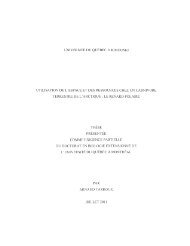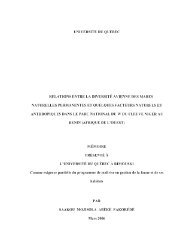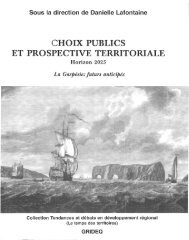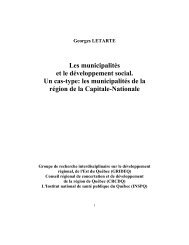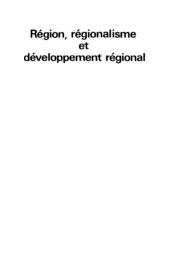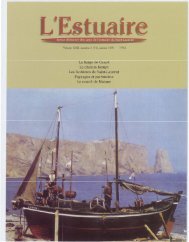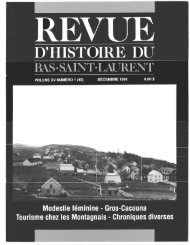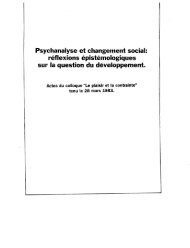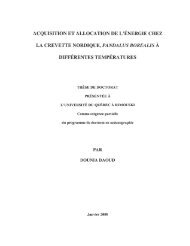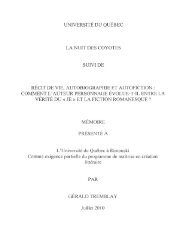influence du climat et de la prédation sur l'utilisation de l'habitat et la ...
influence du climat et de la prédation sur l'utilisation de l'habitat et la ...
influence du climat et de la prédation sur l'utilisation de l'habitat et la ...
Create successful ePaper yourself
Turn your PDF publications into a flip-book with our unique Google optimized e-Paper software.
77<br />
in our popu<strong>la</strong>tion (chap. 3). Males may then lower expo<strong>sur</strong>e to predation by re<strong>du</strong>cing the time<br />
spent outsi<strong>de</strong> of the <strong>de</strong>n wh en snow pen<strong>et</strong>rability, and hence predation risk, is high.<br />
Male and female porcupines showed differences in their patterns of activity and this<br />
may reflect the different constraints that they are faced with. Females being of smaller size<br />
appear to minimize the time spent outsi<strong>de</strong> because of thennal constraints while males seem<br />
more constrained by predation risk. Our study therefore illustrates that behaviour of<br />
generalist herbivores <strong>du</strong> ring winter may be constrained not only by thennal conditions, but<br />
also by constraints on food acquisition and predation risk. We also <strong>de</strong>monstrate that<br />
micro<strong>climat</strong>es vary greatly from one microhabitat to another and that porcupines appear to<br />
use microhabitats to both re<strong>du</strong>ce energy expenditure while resting and maximize energy<br />
intake while feeding.<br />
4.6. Complément d'information<br />
L'un <strong>de</strong>s objectifs <strong>de</strong> ce doctorat était d' examiner si le patron d ' activité <strong>de</strong>s animaux <strong>et</strong><br />
leur utilisation <strong>de</strong> 1 'habitat avaient un impact <strong>sur</strong> leur <strong>sur</strong>vie. Pour ce<strong>la</strong>, nous avons calculé les<br />
valeurs moyennes d'utilisation <strong>de</strong> <strong>l'habitat</strong> pour chaque indi vi<strong>du</strong> <strong>et</strong> avons utilisé ces va leurs<br />
indivi<strong>du</strong>elles pour tenter d'expliquer <strong>la</strong> <strong>sur</strong>vie <strong>de</strong>s animaux au cours <strong>de</strong> 1 'hiver.<br />
Indicateurs indivi<strong>du</strong>els d'utilisation <strong>de</strong> <strong>l'habitat</strong><br />
D ' abord, nous avons calculé pour chaque indivi<strong>du</strong> le temps moyen passé <strong>de</strong>hors en 24 h,<br />
<strong>la</strong> <strong>du</strong>rée moyenne <strong>de</strong>s sOlties, le nombre moyen <strong>de</strong> sOlties en 24 h, l'indice <strong>de</strong> nocturnalité<br />
moyen (Tableau 4.4) au mois <strong>de</strong> février 2004 (n = Il indivi<strong>du</strong>s) <strong>et</strong> au mois <strong>de</strong> février 2005 (n<br />
= 6 indivi<strong>du</strong>s). Ensuite, nous avons calculé les pourcentages moyens <strong>de</strong> fois où chaque<br />
indivi<strong>du</strong> était observé: en train <strong>de</strong> s'alimenter, en haut d'un arbre, en milieu ouvert (Tableau<br />
4.5) au mois <strong>de</strong> février 2004 (n = 21 indivi<strong>du</strong>s) <strong>et</strong> au mois <strong>de</strong> février 2005 (n = 5 indivi<strong>du</strong>s).<br />
Nous avons calculé les moyennes pour le mois <strong>de</strong> février car c'est un mois où nous avions<br />
<strong>de</strong>s données <strong>sur</strong> tout le mois pour <strong>la</strong> plupart <strong>de</strong>s indivi<strong>du</strong>s (<strong>de</strong>ux indivi<strong>du</strong>s sont morts au cours<br />
<strong>du</strong> mois, respectivement le 10 <strong>et</strong> le 27 février).<br />
Ensuite, nous avons testé si les indivi<strong>du</strong>s différaient dans leur patron d'activité <strong>et</strong><br />
utilisation <strong>de</strong> <strong>l'habitat</strong> (Tableau 4.4, Tableau 4.5). Pour ça, nous avons utilisé <strong>de</strong>s modèles<br />
linéaires généralisés dans SAS version 9.l. (SAS 2002) avec l'i<strong>de</strong>ntité <strong>de</strong>s animaux en



